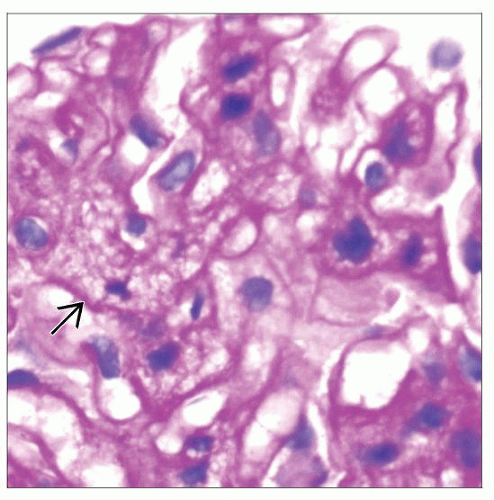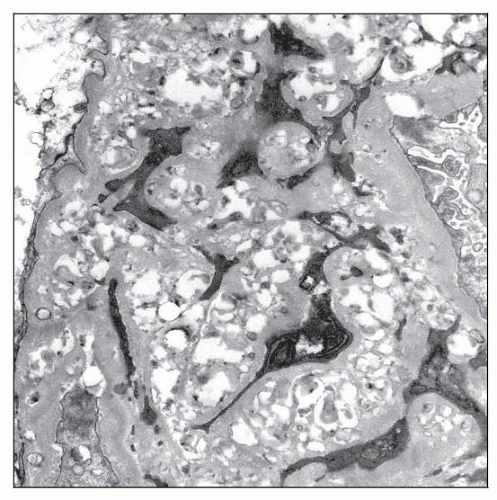Lecithin-Cholesterol Acyl Transferase Deficiency
Ami Bhalodia, MD
Key Facts
Terminology
Complete or partial LCAT deficiency
Familial LCAT deficiency
Fish eye disease
Etiology/Pathogenesis
Defect in LCAT-mediated cholesterol ester-formation
Mutation of LCAT gene on chromosome 16q22
Clinical Issues
Corneal opacities and cataracts
Hemolytic anemia
Renal insufficiency with proteinuria
Atherosclerosis in rare cases
Microscopic Pathology
Glomerular mesangial expansion
Bubbly, vacuolated matrix
Capillary loop thickening
GBM “spikes,” vacuoles, duplication
Tubular atrophy and interstitial fibrosis
Interstitial foam cells
EM: Rounded granular and lamellar dense lipid deposits in GBM and mesangium
Lipid deposits in liver, spleen, and bone marrow
Ancillary Tests
Laboratory tests
Reduced plasma total cholesterol
Decreased high-density lipoprotein
Top Differential Diagnoses
Hepatic glomerulopathy
Alagille syndrome
TERMINOLOGY
Abbreviations
Lecithin-cholesterol acyltransferase (LCAT) deficiency
Synonyms
Phosphatidylcholine-sterol o-acyltransferase deficiency
Definitions
Diseases caused by complete or partial LCAT deficiency
Familial LCAT deficiency (FLD)
Fish eye disease (FED)
ETIOLOGY/PATHOGENESIS
Genetic Disorder
Autosomal recessive
Mutation of LCAT gene on chromosome 16q22
More than 36 mutations described
Defect in LCAT-mediated cholesterol ester formation
Failure to secrete active LCAT into plasma
Accumulation of unesterified cholesterol in cornea, kidneys, and erythrocytes
LCAT normally carried in high-density lipoproteins (HDL) with ApoA1
Decreased HDL
Increased free cholesterol-phospholipid vesicles (LpX)
Animal Model
Murine LCAT deficiency (increased LpX)
CLINICAL ISSUES
Epidemiology
Incidence
Rare cases reported worldwide
60 with complete LCAT deficiency
20 with partial LCAT deficiency
Ethnicity
Initially reported in Norway
Now appears widely distributed
Presentation
Complete LCAT deficiency
Familial LCAT deficiency
Corneal cataracts
Hemolytic anemia
Renal insufficiency by 4th decade
Proteinuria may begin in childhood
Progression of renal disease is variable
Atherosclerosis in rare cases
Hypertension
Partial LCAT deficiency
Fish eye disease
Corneal opacities
Resemble eyes of a boiled fish
No overt renal disease
Laboratory Tests
Reduced plasma total cholesterol
Decreased HDL
Low LCAT activity in plasma
Urinalysis shows hematuria, leukocyturia, and casts
Treatment
Medical treatment for anemia, renal insufficiency, and atherosclerosis
Renal failure
Dialysis
Renal transplantation
Corneal transplantation
Prognosis
Renal transplantation
Moderately successful
Does not reverse serum lipoprotein abnormalities
Mesangial lipid deposits recur within weeks
Do not initially impair renal function
MICROSCOPIC PATHOLOGY
Histologic Features
Glomeruli
Mesangial expansion with occasional increased cellularity and foam cells
Mesangium appears bubbly or vacuolated
Capillary loop thickening
Silver stain shows GBM “spikes” and vacuoles
Stay updated, free articles. Join our Telegram channel

Full access? Get Clinical Tree





